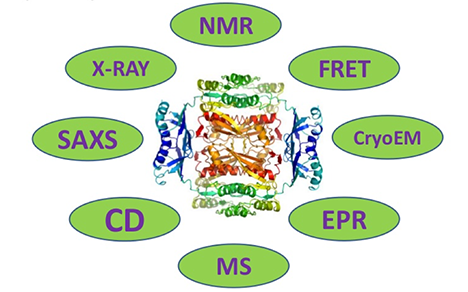As one of the major macromolecules, proteins are present in all biological organisms to catalyze biochemical reactions. They play an important role in transportation and storage of chemical compounds and also initiation of immune responses. They also play an important role in the structure maintenance of biological components, the conversion of chemical energy into mechanical energy during muscular movement and the signal transduction. They take part in almost every process within biological systems, with their activity and function depend on their structures. Three-dimensional structures of proteins offer unique insight into macromolecular function and mechanism and has become an important assistance for targeted drug design. What's more, the relationship between structure and function, protein folding and evolution can be inferred from a set of structures.
In the early days, it is difficult, time consuming, labor intensive and problematic to determine protein structures and it usually required years of efforts. For example, it took about three decades to complete the structure determination of the first protein. This picture is significantly changed when technological breakthroughs in protein production, crystallization and other structure solutions came into being. Nowadays, the structure of many soluble globular proteins can be determined routinely, though the structure of large protein complexes and membrane proteins remains hard to determine.
Currently, many methods are available for the structure determination of proteins. X-ray crystallography, has made the largest contribution to our understanding of protein structures, although the other methods have complemented our data when crystallography not applicable. Each method has its advantages and limitations.
X-ray crystallography has been a widely used, highly automated technique to obtain protein structure information. X-ray crystallography provides near atomic resolution and small details of the protein structure with very high accuracy. However, crystallization of the protein, which usually takes months, is necessary for X-ray crystallography. It also requires relatively large amounts of the protein.
 Fig1. Protein Structure Determination
Fig1. Protein Structure DeterminationNuclear Magnetic Resonance (NMR) spectroscopy also plays an important role in the determination of the structures and dynamics of biological macromolecules. NMR spectroscopy allows for the protein structure being studied nearly under physiological conditions for proteins difficult to crystallize. However, NMR spectroscopy does not provide near atomic of resolution and is hard to automate. The proteins for NMR spectroscopy should be of small size and remain stable in solution at room temperature for the long duration of data acquisition. Also, large quantity of proteins is needed.
Electron Microscopy and Cryo-Electron Microscopyare appropriate for determination of the tertiary structure of a single particle, large macromolecule complexes or even bigger cellular organelles. Though the resolution is less than that of methods like NMR spectroscopy or crystallography can visualize protein structures at very high resolution with minute amounts of protein. Though enabling researchers to obtain a three-dimensional picture of a protein, homology modeling needs prior knowledge of the close homologue or template which has highly conserved amino acid sequence. Protein advanced structure analysis services available at Creative Proteomics are as below.
Secondary Structure Analysis
- Circular Dichroism Spectra (Far UV)
- Fluorescence Spectroscopy
- Nuclear Magnetic Resonance (NMR) Spectroscopy
- FT-infrared Spectroscopy
- Native Mass Spectrometry Analysis
Tertiary Structure Analysis
- Circular Dichroism Spectra (Near UV)
- Hydrogen Deuterium Exchange Mass Spectrometry (HDX-MS)
- X-ray Crystallography
For more details, please feel free to contact us or send inquiry directly.






